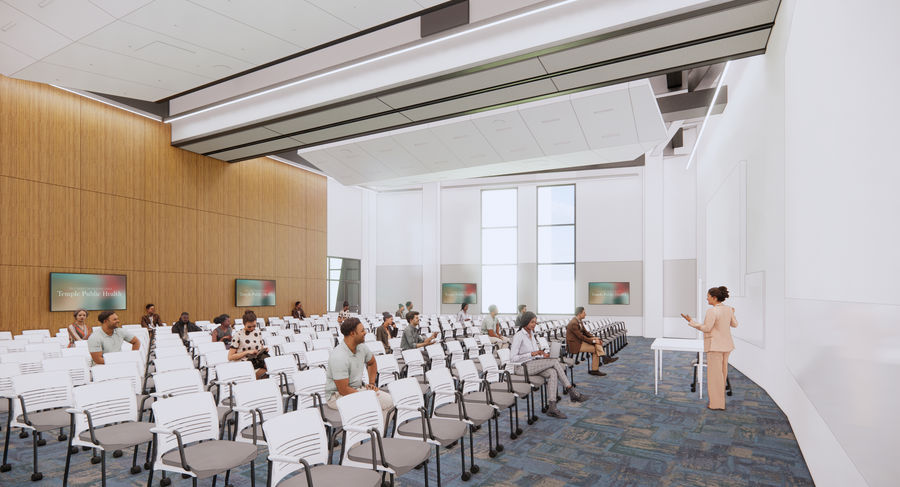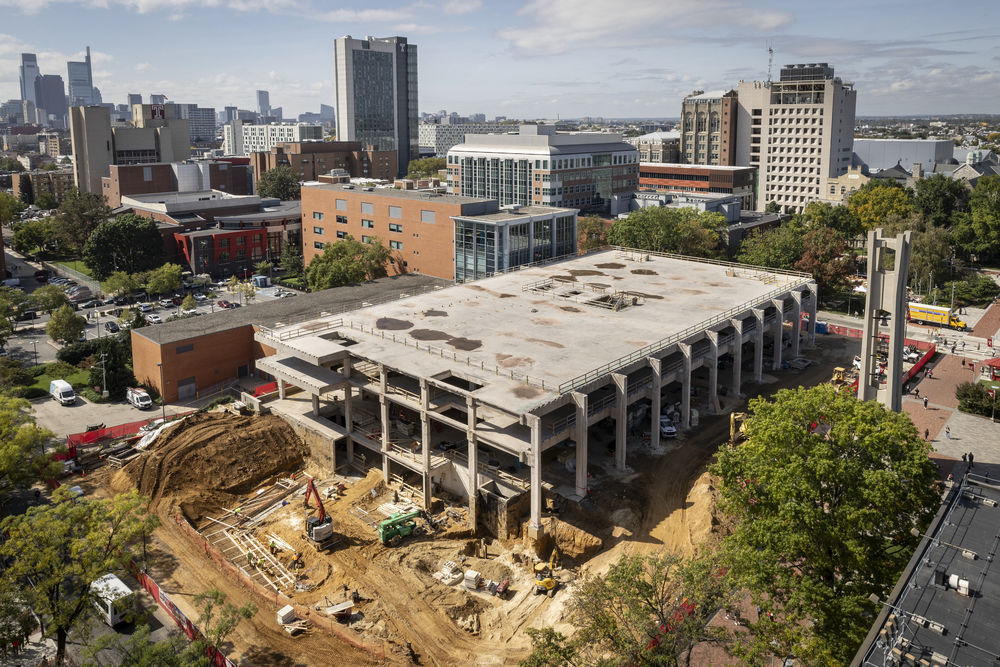
The jackhammers and cranes went to work this spring on the former Paley Library at the heart of Temple’s Main Campus, beginning the process of transforming the iconic building into Paley Hall, the first unified home for the College of Public Health. After years of planning, the project’s pace picked up over the summer, as if responding to an urgency.
Public health education in these post-pandemic days has never been more vital. The disciplines under the CPH umbrella—including nursing, epidemiology, rehabilitation sciences, social work, behavioral health, and policy—have never been more in demand. They need graduates to enter the workforce, after many health professionals have retired or left their fields due to stresses of recent years. There is growing demand for well-trained researchers who are ready to find evidence-based solutions to rising public health challenges.
The library’s partial teardown will evolve quickly into a resurrection of Paley as a state-of-the-art teaching and research facility, including inviting spaces for students.
“We will see the building’s exterior done, right there in the center of campus, in 2024,” said Jennifer Ibrahim, dean of the College of Public Health. Paley Hall is scheduled to open in the fall of 2025, its central location beside the Bell Tower on Polett Walk reflecting the importance of public health education at the university, in Philadelphia, and globally. "
Paley will feature classrooms, training and simulation centers, meeting and study rooms, an expanded Social Service Annex for students, faculty and administration offices, café areas, and a Temple bookstore with a separate entrance. It will unite departments that have been spread across a dozen buildings on two campuses. Administrative and college leadership offices will relocate across 12th Street from the Bell Building. The nursing department will move its base to Paley from the Health Sciences Center. Every aspect of Paley’s design, by PZS Architects and S/L/A/M, is intended to support the college’s hallmark approach to interprofessional education, the belief that public health response is strengthened when multiple disciplines come together.
“Public health transcends single academic departments. Violence, trauma, nutrition, obesity, addiction, social determinants, community inclusion, shared patient decision-making, social justice...there will be so many opportunities for faculty, students, and the community to collaborate around these issues in our new home,” Ibrahim said.
Design for collaboration



On the ground floor, subdividable teaching space with modern instructional technology will allow for 230-person lectures or up to four separate classrooms. The first level will have a fully equipped teaching kitchen for nutrition and food preparation classes and community programs. Concrete panels around the façade of the old building, initially designed to keep sunlight away from library materials, have been removed to allow natural light to flow into learning and meeting spaces, including a 4,000-square-foot lobby atrium, which can be used for impromptu meetings and as an amphitheater.
“We created an atrium space that steps up through the building,” said Michael Skolnik, a partner and architect at PZS, which also worked on Temple’s Morgan Hall. “We have a large stair to encourage movement from the lobby up through each level, circulating through this light well.” The building will be LEED certified, for sustainable design and operation, and will be the first on Temple’s campus to request WELL certification, for features that improve occupants’ wellness such as ventilation, light, fitness, and comfort. “Views and nature are important with WELL design, so there are great views to the outside, and we bring nature in with a biophilic wall, a planted wall that’s a focal point of the atrium,” Skolnik said.
On the second floor, training centers will include a simulated community and urban home, where students pursuing disciplines such as physical, occupational, and recreational therapy can practice helping clients move in and across varied environments. The simulated community will include a café and a small park environment with benches, green turf, and curbs. A partial row home will include a bedroom, bathroom, laundry room, kitchen, and dining area. A bedside care skills lab will have inpatient rooms, beds, and equipment to simulate a hospital environment. The Emergency Medical Services Skill Lab, for the college’s new EMT program, will include a partial ambulance for practice with patient transfers.
“I think the college is about to knock it out of the park with the sim labs for clinical instruction,” said Cynthia Abbott-Gaffney, associate professor in the occupational therapy program. “Clinical students work in the field as a part of their training—that’s a big part of what Temple does. But the sim center will allow predictably scheduled, practical learning experiences, where they can hone their decision-making and problem solving, increasing their readiness for those real-world experiences. I wish this were around when I was a student.”
A fifth floor, as well as tiers of green roofs, will be added to the four-story structure. The upper levels of the building will be home to the seven departments in the college and include a wide range of collaborative spaces to advance interdisciplinary education and research. Given recent renovations, some CPH labs and classes will remain outside Paley for now, including anatomy and physiology and athletic training labs in Pearson-McGonigle Hall and the Aramark STAR Complex, which opened in 2017.
The $162 million project is being financed by the College of Public Health with support from the Commonwealth of Pennsylvania. In April, the college launched Public Health to Change the World, a capital campaign for the College of Public Health, to support the construction and fund student scholarships and faculty research.

The original Paley Library was part of an approximately $6 million project, with $5 million coming from the state and around $1 million from the Samuel L. Paley Foundation. Designed by Temple’s campus master planners Nolen & Swinburne, it opened as the university’s main library in October 1966 and became a home base and study center for decades of students. It had a midcentury-modern design and held more than a million books.
The same project included construction of the Bell Tower, or campanile, establishing a central landmark on Main Campus. The campanile’s five bells were imported from Holland, and stones at its base came from the farm of Ali Hafed in Pakistan, whose story inspired Temple University founder Russell H. Conwell’s “Acres of Diamonds” lectures and his advice to “look in your own backyard for the riches you seek.”
In 2019, Temple transferred 1.8 million books and other items to the new Charles Library. The College of Public Health had been eyeing a unified home for its dispersed departments since its founding in 2014, and the vacated Paley building became a prime candidate.
“Once we made the decision to form the College of Public Health, it was obvious that being spread across 12 to 14 buildings, depending on the year, was not conducive to creating an atmosphere in which we could have this interprofessional education and research,” said Laura A. Siminoff, who served as dean of the College of Public Health from 2014 to 2022.
Public health’s rise
The college has grown in prestige and scope over those years, most recently jumping to No. 36 among the nation’s schools and programs of public health in the 2023–24 edition of U.S. News and World Report’s Best Graduate Schools. More than 4,000 CPH students are pursuing undergraduate, master’s, and doctoral degrees, and graduate enrollment has grown 15% over the past four years. The college has 60 research centers and labs, approximately 165 full-time faculty members, and nearly $70 million in active research grants.
Temple’s 2014 master plan, Visualize Temple, called for both a unified home for the College of Public Health and a repurposing of the Paley Library.
“It suggested that because Paley is so prominently located at the Bell Tower, whoever occupies that building should be prominent within the university,” said James Templeton, Temple University architect and assistant vice president for the Project Delivery Group. “At some point, leadership decided that the College of Public Health is incredibly important on our campus, and we have this building we can renovate.”

The cranes and jackhammers took a short pause on a brisk morning this April for the official groundbreaking, attended by public officials, university leaders, and supporters.
“Temple is one of the most important institutions in our city,” Philadelphia Mayor Jim Kenney said at the event. “The development of a new, innovative space to advance public health within the college and across the campus and North Philadelphia is very, very exciting.”
Ala Stanford, founder of the Black Doctors Consortium and former director of the Center for Minority Health and Health Disparities at Temple’s Lewis Katz School of Medicine, agreed. “To have Temple University invest further in the North Philadelphia community, specifically in this area of public health, is both needed and appreciated,” she said. “I say that as someone who was born and raised in North Philadelphia. I am grateful that the College of Public Health is not just doing the research and the study, but they are acting. This community will greatly benefit.”
“Being together, having debates and discussions, inviting our community partners into this amazing space, it will be a giant step forward,” Ibrahim says. “Whether it’s in the teaching kitchen, showing ways to have nutritious meals in the context of food deserts, or bringing community partners into the sim center to innovate on how to provide health and social services in the community (not just a clinical setting), it’s going to be a game-changer in how we train our students, research the complex health questions before us, and advance health for the community.”
